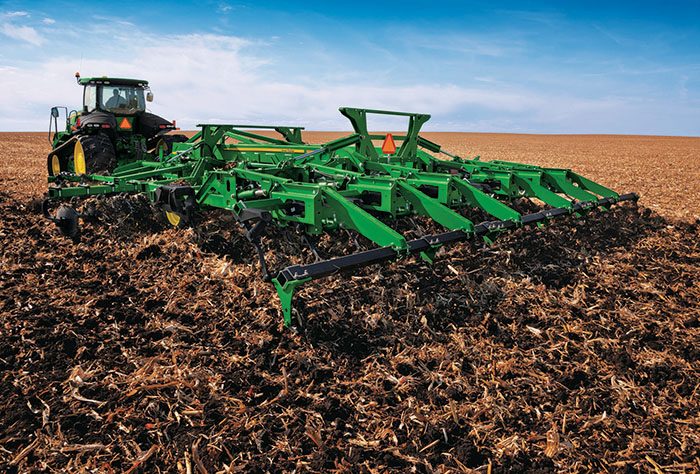John Deere’s introduction of TruSet Technology on the JD 2730 combination disc ripper in 2015 marked the beginning of tillage tool “intelligence.” The on-the-go depth and pressure control of TruSet was enhanced the following year with GPS/RTK mapping and data collection capability. Photo Courtesy of John Deere
The reduced tillage movement continues to grow in the U.S., fueled by economic and environmental concerns, but fully 60-75% of the nation’s farmland remains in “conventional” farming — with growers relying on pre-plant tillage and soil preparation to create a field-wide, soft, friable seedbed.
“It’s probably simpler to obtain higher yields using conventional tillage,” says Mark Van Steen, Salford Group Inc., “But the biggest drawback is, if you don’t watch what you’re doing you can eventually burn out carbon, and you’ll deplete your soils over time.
“Wind and water erosion can also become issues, but you can still address those situations with conventional farming,” he explains. “I certainly know conventional farmers who put their residue back in the soil and use tillage when they need it — not as a broad spectrum approach. With the use of cover crops and residue management, they are actually able to maintain their soils and soil health.”
Iron-in-the ground farming also is particularly prevalent in regions growing tough-stubble GMO corn and in areas plagued by populations of herbicide-resistant weeds.
While few conventional growers continue to cling to the ancient “tillage” is “farming” mentality, most growers who don’t check “No-Till” on farm magazine surveys farm the way they do for a reason.
In a recent panel discussion, several leaders in the tillage business discussed the fragmentation of farming methods found on today’s farms and the various problems equipment makers are asked to solve in engineering new tillage tools for those growers.
Tom Draper, AGCO’s strategic marketing manager in seeding and tillage says most growers are developing their own “recipe for success” based on their location, their crop rotation and soils.
“I think tillage farmers today are realizing it’s not so much the tool that is important, as it is what they want and need the tool to do to in their own operation,” he explains.
Mike Cleveland, vice president of sales at Great Plains Mfg., says in many cases a grower with 3,000-4,000 acres may be farming part of that land with conventional practices, another part no-till and other fields in vertical or strip-till management.
“It’s becoming farm specific, or field-specific, and that’s a move away from the practice I grew up with where we did the same thing every year in every field,” he explains.
Cleveland says tillage equipment designers are now faced with developing tools to keep farmers in compliance with government regulations, plus ensuring the tools don’t create more problems than already exist in fields.
“We have to reduce erosion, which has been around throughout recorded history. We have to work for better water infiltration, which also leads to better root growth, because root growth leads to better nutrient uptake, and when we’re through, we have to provide a seedbed that promotes uniform emergence,” he explains.
“Tillage used to be defined as making the soil as dark and level as possible,” explained one product manager in a recent tillage survey. “Today, the definition has to include:
- What to do with residue from 300 bushel Bt corn.
- The ability to get over a field in an ever-decreasing window of weather opportunity.
- The ability to leave just the right amount of residue on top to manage moisture and erosion.
- And, correcting — or not adding to — compaction problems in the field.
As “productivity” becomes the by-word for remaining profitable by farming more quickly with fewer field passes and less fuel consumption, tractors are approaching the 700 horsepower range to pull equipment that engineers say is pushing the limits on transport and foldability. Also, compaction issues found behind the heavy equipment are driving efforts to find lighter materials and designs.
Herbicide-resistant weeds and a growing market for organic farm products are moving more growers back to tillage, and given the need for “productivity” it’s becoming apparent existing cultivator designs are not wide enough or fast enough to keep up the pace with modern, wide, high-speed planters.
New tools are needed to help incorporate cover-crop residue in areas where mono-crops are being replaced by seasonal rotations, and environmental challenges are making shallow incorporation necessary to enhance phosphorus and potassium fertilizer placement.
The challenges are great, but the past 5 years have seen significant development in tillage tool technology that promises to address the “many-problems-of-farming.”
Adding IQ to ‘Dumb Iron’
As precision farming began 25 years ago, it guided tractors and harvesters, then it began collecting information on yields and crop conditions, and quickly graduated to variable rate technology on planters, sprayers and nutrient application systems. Tillage equipment, however, continued dutifully following the tractor and took on the name “Dumb Iron.” No more.
As with tractors and harvesters, tillage tools began developing an IQ as strip-tillers demanded more accuracy of their equipment and installed GPS/RTK guidance on their strip-till machines. By mapping with the strip-tiller and using the same GPS/RTK system to guide the planter, growers found they were seldom off more than an inch even in the most challenging field conditions.
In 2015, John Deere introduced TruSet technology that allowed in-the-cab depth and pressure control on four functional areas of its JD 2730 Combination Disc Ripper. A year later, TruSet Tillage Technology was GPS-enabled to gather data. This allowed the grower to look at geographic locations and machine adjustments and compare them with yield maps generated at harvest.
“That feature allows us to create maps and prescriptions based on previous yields, soil surveys, or freehand drawing,” says Nathan Kramer, Deere’s tillage marketing manager. “With those maps and prescription loaded, drivers turn into operators as the machine automatically adjust throughout the field based on its GPS position.”
The data-gathering software is available for all TruSet capable machines, and can be retrofit to those machines sold before the capability was introduced.
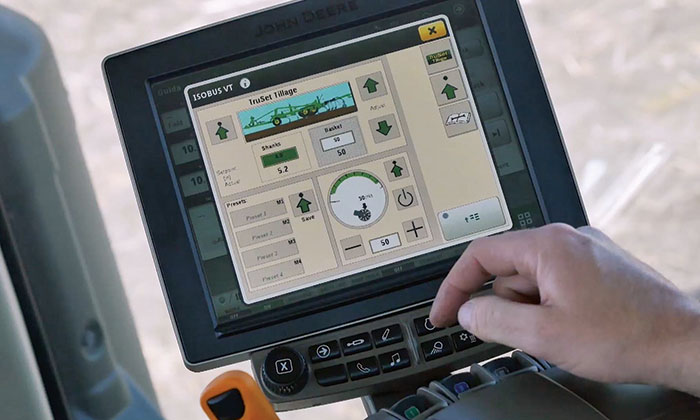
TruSet systems like this one for a field cultivator allow the operator to communicate with the implement through the CAN ISOBUS system to adjust individual section control and leveling in 1/10-inch increments, making needed changes in six seconds while underway. Photo Courtesy of John Deere
Today, in addition to the 2730 combination ripper, TruSet is available on the JD 2720 Disc Ripper, the JD 2510H nutrient applicator, JD 2230 field cultivators, JD 2330 mulch finisher and JD 2620 series and new 2630 series discs.
Kramer says the controls on the JD 2730 include depth on the front disc gang and ripper shanks, and closing discs and pressure on the rolling baskets. Depending on the machine form, TruSet controls depth and pressure or pressure only.
“TruSet works through a number of position sensors on each section monitoring wheel position. This allows the machine to operate in a variety of soil conditions with the ability to correlate depth according to wheel position,” Kramer explains.
“We already had a hydraulic pressure reducing valve to adjust basket pressure; we took the same built-in logic on our base machine and gave the customer the ability to adjust basket pressure directly through the display in the cab” he says.
A critical piece of TruSet is an ability to shorten the learning curve for users.
Kramer says the user interface has four pre-sets the owner can select at the beginning of the season.
“For instance, we might call one ‘headlands’ for areas where we know there will be more compaction from truck and grain cart traffic. We’ll need to go a little deeper in those areas with rippers and shanks to mitigate the compaction.
“Another might be ‘hilltop’ for lighter soils and areas where we have to be cautious not to turn up too much soil and expose it to erosion. Here, we’d raise the depth, but keep the rolling basket pressure the same.
“A third might be ‘river bottom’ or ‘heavy soil’ where the adjustments would match conditions in tighter soils,” he explains.
“This is somewhat of a ‘semi-automatic’ mode in which the operator realizes soil conditions have changed and can hit the proper preset to adjust the machine on the go.”
Over time, Kramer says operators become accustomed to the presets and are more likely to program the machine for automatic control once they see the value of the machine making the changes swiftly and accurately.
“Once customers experience the system, they see the value of not stopping to make adjustments; they can look at their field operation history and compare yields and fuel consumption with different tillage settings. That makes it easier for them to do more automation in the future,” he says.
“As we developed the system, we measured making adjustments manually on the JD 2730 would take 12-20 minutes. As the system operates, those same adjustments take only 6 seconds, and we can make those adjustments in one-tenth of an inch increments,” Kramer explains.
“In ripping, such accuracy really isn’t a problem, but a seedbed being off by a quarter of an inch can really matter,” he says. “Also, the system allows you to see — on the monitor — the exact depth the machine is running to one-tenth of an inch. You don’t have to stop and check a gauge marked A through G“.
Kramer says the system can be accessed through Deere’s new 4600 integrated display and is compatible with 2630 and newer displays.
Field Interactivity
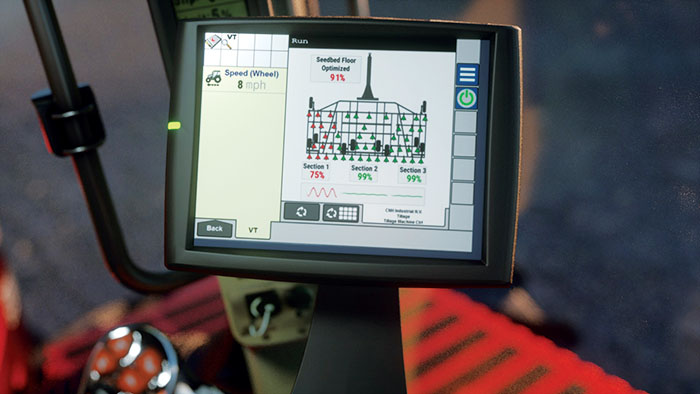
Case IH’s AFS Soil Command system installed on its 255 Tiger-Mate Field Cultivator gives the operator an in-cab view of Go, Caution, and No Go conditions at the shank. The interactive system is designed to warn of ruts and gouges in the seedbed floor, which could cause subsequent planter hop and misplacement of seed at planting. Officials say the system is slated to receive data collection capability in the near future. Photo Courtesy of Case IH
Earlier this year, Case IH introduced its AFS Soil Command system on the Tiger-Mate 255 field cultivator. The system helps producers measure and optimize seedbed agronomic quality on-the-go from the cab.
Tillage Marketing Manager Chris Lursen says Case IH has had a long-term interest in helping growers improve their seedbed even though that part of farming seems to have remained a mystery for many years.
“The seedbed floor — where tillage sweeps run — is an area that’s not well known because you can’t see it and you have no idea if you’re doing a good job,” he explains.
“The seedbed floor has to be uniform and smooth, otherwise it causes a planter to bounce, particularly at the higher speeds of today’s planters, and bouncing causes problems with seed placement and spacing — both of which are directly related to yield,” he says.
Lursen says modern down force systems help but they can’t do anything about an irregular or ‘washboard’ seedbed floor. “We wanted to be proactive with AFS Soil Command,” he explains.
The system consists of sensors mounted on shanks on the various sections of the cultivator, left, right and front and back.
“The sensors measure the position of the sweep by the pivot angle of the shank,” Lursen explains. “If it begins to pivot it’s a poor seedbed, and it sends a signal to the display in the cab to alert the operator the sweep is nosing down and furrowing.”
In the cab, the display has an image of the field cultivator with red, yellow and green indicator lights at the position of each sensor.
“Green is good to go,” Lursen explains. “Yellow indicates troubling conditions, and red indicates the seedbed floor will likely cause planter row-unit bounce.”
Display warnings alert the operator of excessive field speeds, depth adjustment incorrect for conditions, improper leveling from side to side, and forward tipping of the entire tool.
Lursen says the feedback system is comparable to seed spacing measurement introduced on planters several years ago.
“Automation is on the horizon and AFS Soil Command is one of mechanisms to get us there,” he explains.
Do Some Digging
As precision farming becomes more accurate in its mapping, growers are finding one of the biggest yield robbers they face is compaction, or “soil density change layers” within their fields. Compaction interrupts the natural water cycle by impeding infiltration of precipitation and irrigation water, it prevents roots from adequately penetrating the root-growth zone and restrains their ability to take up available plant nutrients.
Mike Cleveland, of Great Plains Mfg., acknowledges these layers can be formed by tillage. But, he says other things, such as 35,000 pound combines loaded with 20,000 pounds of grain, and 60,000-90,000 pound loaded grain carts pulled by 30,000 pound tractors can cause deep density change layers.
“Regardless of their cause, subsoiler tools can reset the soil profile to break up compaction layers,” he says. “That’s a process we see our farmers using once every 3-4 years.”
Once the profile has been reset to eliminate deep compaction, Cleveland says growers don’t usually put a lot of compaction back in the deep regions with typical farming operations, but they usually do have to continue dealing with surface layers that can inhibit root growth and water infiltration.
AGCO’s Tom Draper says in many cases growers take a surface view behind their equipment and convince themselves the tools they are pulling are doing a good job.
“They don’t realize it’s like looking at the ocean and saying ‘Yeah, it’s a big ocean,’ while never considering how deep it is,” he explains.
“We encourage all of our customers to dig before they plant, after they run that tillage tool,” Cleveland adds. “What you see on the surface can be smooth, but what your planter sees is an inch and a half or so underground.”
Chris Lursen, Case IH, agrees, and says he suggests growers dig behind every section of their field cultivator.
“You want to know that when you wipe away that 2-3 inches of soil that it’s flat underneath to ensure the seed bed floor doesn’t cause problems with planter ride and depth adjustment,” he says. “Dig behind every single section!”
“We will collect data from each sensor and create a map on the display or software. Also, we plan to present it with telemetry for remote sensing of operators by farm managers and owners.”
Lursen says much of the testing of AFS Soil Command was done in central Illinois on cooperator farms.
“We were amazed at how the system showed us things we hadn’t caught while we set up the machine. Even the smallest adjustments made significant improvements,” he added.
Vertical Tillage & More
Earlier comments about growers using different tools and methods on different fields within their farms mirror the goals of equipment makers developing new products.
Jamie Meier, sales and marketing manager at Landoll says his company’s new 7500-Series VT-Plus is a good example of how vertical tillage technology evolved to meet customer demands for different geographic conditions. Vertical tillage became popular because of its low soil disturbance and relatively high operating speeds.
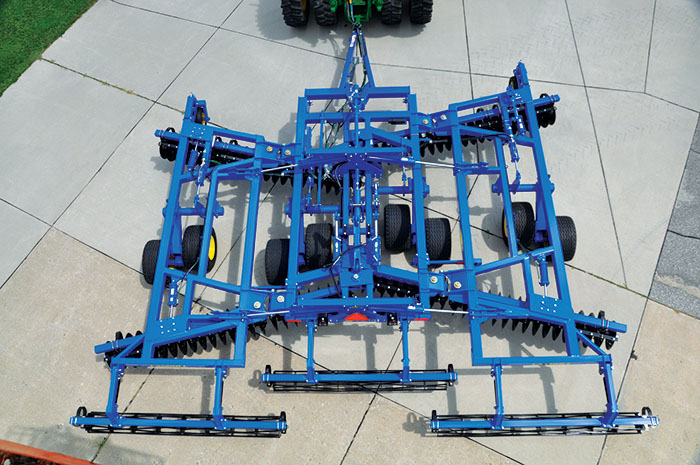
The hydraulics that allow on-the-go disc gang angle adjustment on the Landoll 7500 VT-Plus vertical tillage tool are obvious in this overhead shot. The modified VT tool is designed to allow in-cab adjustment of disc angles to better deal with field and residue conditions. Photo Courtesy of Landoll
“We started out with a vertical tillage tool we called the VT that could really work the ground and handle residue,” he explains. “But, we realized if we left all the residue on top, completely cut loose, it could present issues with wind and water erosion.
“Our guys in Texas were running VTs and they had a lot of residue on the surface behind them. They get a lot of wind in Texas and the lighter residue was blowing away, so they wanted a tool that was a little more aggressive, especially for fall residue. They wanted to throw more dirt.”
To answer that challenge, Landoll introduced the adjustable gang VT-Plus which features in cab hydraulic gang angle adjustment from 5-15 degrees, to kick up more soil if its needed to anchor residue on erosion-prone fields.
“Our VT is set up on a 10-degree gang angle. With the new VT-Plus, we can go to 15 degrees or back it off to 5 degrees to give a lot of versatility in the field. If we have more weed pressure, or if we have some ruts from last fall, we can increase the gang angle, kill the weeds and smooth out the ruts,” Meier explains.
“The gangs move at one time, all on one system,” he says. “There are no pins to change and all the adjustments can be made on the fly. Front-to-back leveling, too, is hydraulic and can be changed on-the-go from the cab.”
The 7500 VT-Plus features 24-inch low concavity blades set on 7-inch spacing. The machine is available in 14 to 32-foot working widths.
A Matter of Residue & Clods
Regardless of what tools you use, Kuhn-Krause Director of Marketing and Product Management Curt Davis, says proper seedbed preparation deals with three important factors.
“The first thing is definitely residue management,” Davis explains. “Being able to cut up residue and size it properly and mix it into the soil where you get an even distribution is key. You don’t want hot spots or bunching or streaking of residue because that affects germination and has a detrimental effect on the final yield of the crop.
“If just one of those seeds in 17 and a half feet fails to emerge, that can have as much as a 7% impact on final yield, so residue management becomes vitally important to productivity.”
Davis says the other big consideration is clod size.
“To have an appropriate aggregate size and to be able to get good seed-to-soil contact, a good rule of thumb is anything greater than two inches of clod size will affect performance of corn and soybean seeds at planting,” he explains. “Corn is particularly sensitive to seedbed conditions and depends upon good seed-to-soil contact for the moisture it needs to germinate.”
The final seedbed quality is overall firmness, Davis says.
“Having a proper firmness ensures we don’t lose moisture, so the more we firm the seedbed to protect moisture and help increase the soil temperature the better we enable the seed to germinate, sprout and take root.”
High-Speed Disc Tillage
Increased field speeds of wide planters makes it difficult for field preparation to catch up, particularly if a planting window is closing and there are still acres to cover ahead of the planter.
Such productivity issues were part of the driving force behind Kinze Mfg.’s addition of four high-speed disc tillage models this year, says Susanne Veatch, Kinze president and chief marketing officer.
The new Mach Till 201, 261, 331 and 401 are based on a Canadian design by Degelman Industries and are licensed for Kinze to produce at its factory in Williamsburg, Iowa.
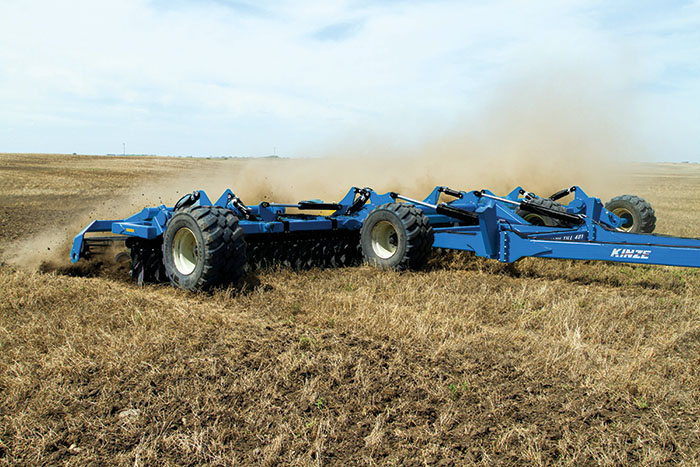
The Mach Till 401 is one of four models of high-speed disc tillage tools unveiled recently by Kinze Manufacturing. Sporting wide flotation tires and working widths from 20-40 feet, the machine is not a vertical tillage tool, but features angled disks and non-smearing soil flow to deal with residue in rapid seedbed preparation. Photo Courtesy of Kinze Mfg.
Veatch says the Mach Till line, capable of 8-12 mph field speeds, allows Kinze to improve its strong brand in planter and grain cart equipment with instant access to the growing high-speed disc segment with a proven product.
“Every year we survey our dealers and ask them various questions,” Veatch explains. “Over the past 2 years we’ve asked them, ‘If Kinze were to expand our product offering what would you like to see?’ The number one request that came back was ‘tillage’.”
Veatch says Degelman and Kinze are aligned well in philosophy about building a quality, well-built, durable product that is simple to use.
“They have had good success in Canada with this machine known as the Pro-Till but they’ve been unable to keep up with the high demand in this emerging market,” she explains. “So they asked us to help them build their yellow Pro-Till, while at the same time we will be able to build our Kinze blue Mach Till.
The new-to-the-U.S. Mach Till comes in four models ranging from 20-feet to 40-feet wide and will be available in the U.S., Canada, Eastern Europe and Russia.
Veatch is quick to point out the Mach Till is not a vertical tillage machine despite it being termed a high-speed disc tillage product. “The Mach Till can run fast, but what’s happening the in ground is much different than VT machines,” she explains.
“The Mach Till combines some of the benefits of conventional discs, vertical tillage and soil finishing products into one tool and then integrates speed, good soil finish and uniform residue management in a wide variety of soils. The design cuts at an angle and throws the soil to avoid creating a smear or compaction layer in the seedbed.
“As that soil flows through the machine it gets mixed with the residue and a corrugated rubber roller in the rear sheds the soil, breaks up larger clods and consolidates the soil leaving the residue and fine earth mixed to aid in decomposition. Behind the machine, the path provides an eye-appealing soil finish which anchors residue in place,” she explains.

